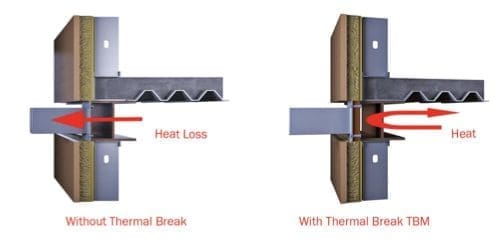Use TBM-3 as a thermal break in connections where high compressive strength is not required. It can be used as a thermal break in between steel purlins and roof or wall panels in metal building applications providing continuous insulation where thermal bridging normally occurs. It is also ideal for use in or as a buck for metal-framed window and door installations, reducing heat loss between the metal frames and steel stud framing openings. Likewise, TBM-3 thermal break material can be used as a thermal break at curtain wall transitions.
The thermal conductivity of a material is a function of its conductance and is an important value in determining the rate at which heat flows through that material. Heat flow is also dependent on area and temperature. To be effective, a thermal break has to have a much, much lower thermal conductivity than the material it is “breaking”. Since the conductance of a material is a function of its thickness, both thickness and area are important in heat flow calculations for a thermal break.
Thermal break material™ (TBM-3) is available in thickness of 1″ to 4″. In any connection design using a thermal break, the goal is to find the appropriate thickness/area combination that helps the wall or roof assembly meet the U value requirement based on climate zone and energy code.
Thermal Break Material™ TBM-3 is a reinforced, non-absorbent, composite manufactured using non-combustible materials. The primary benefit of this thermal bridging solution is that it is non-combustible. As such, it is not necessary to conduct NFPA 285 or ASTM E119 fire rating tests (when required) when Thermal Break Material™ TBM-3 is incorporated in wall or roof assemblies.
High-performance building material




